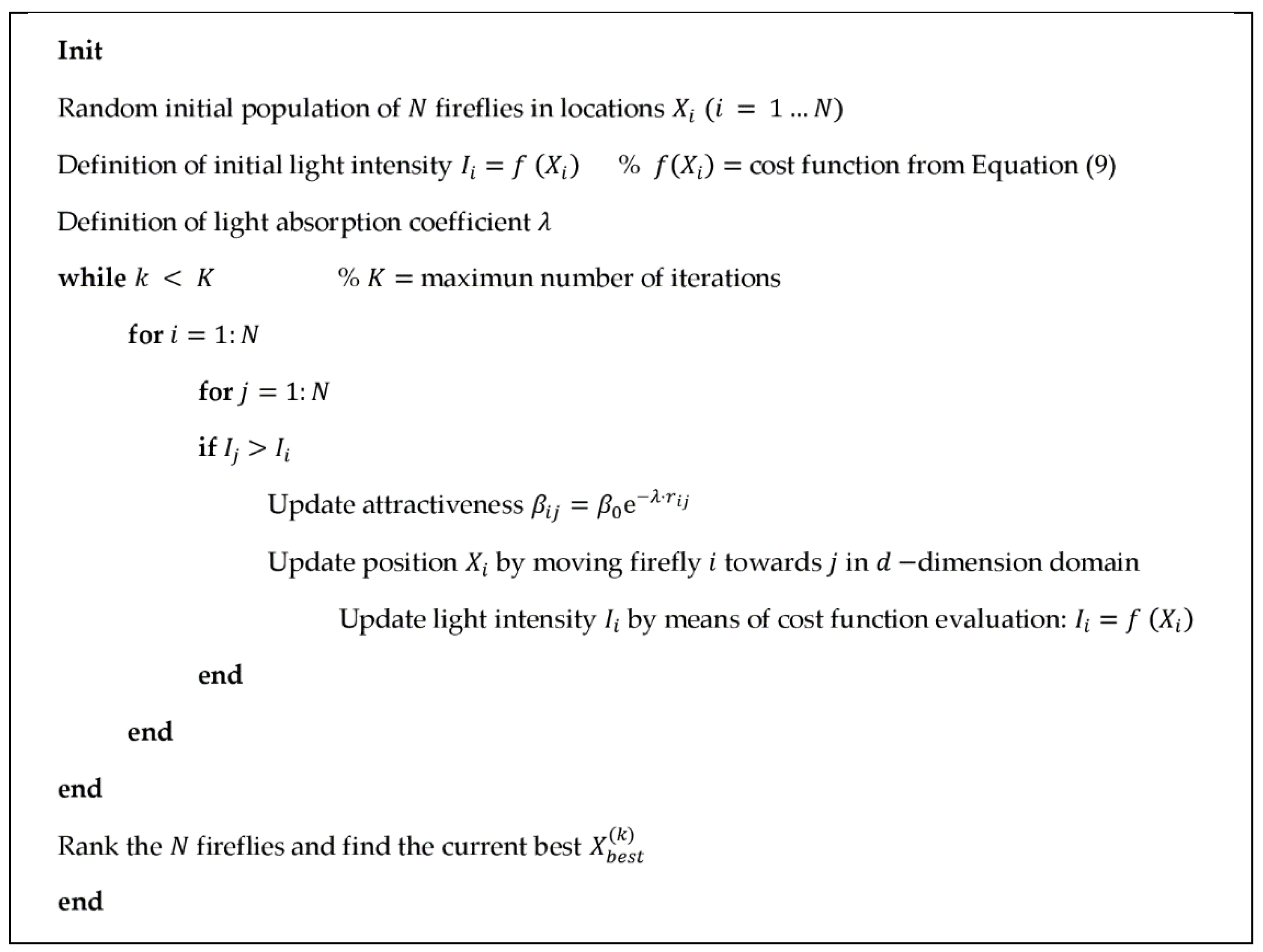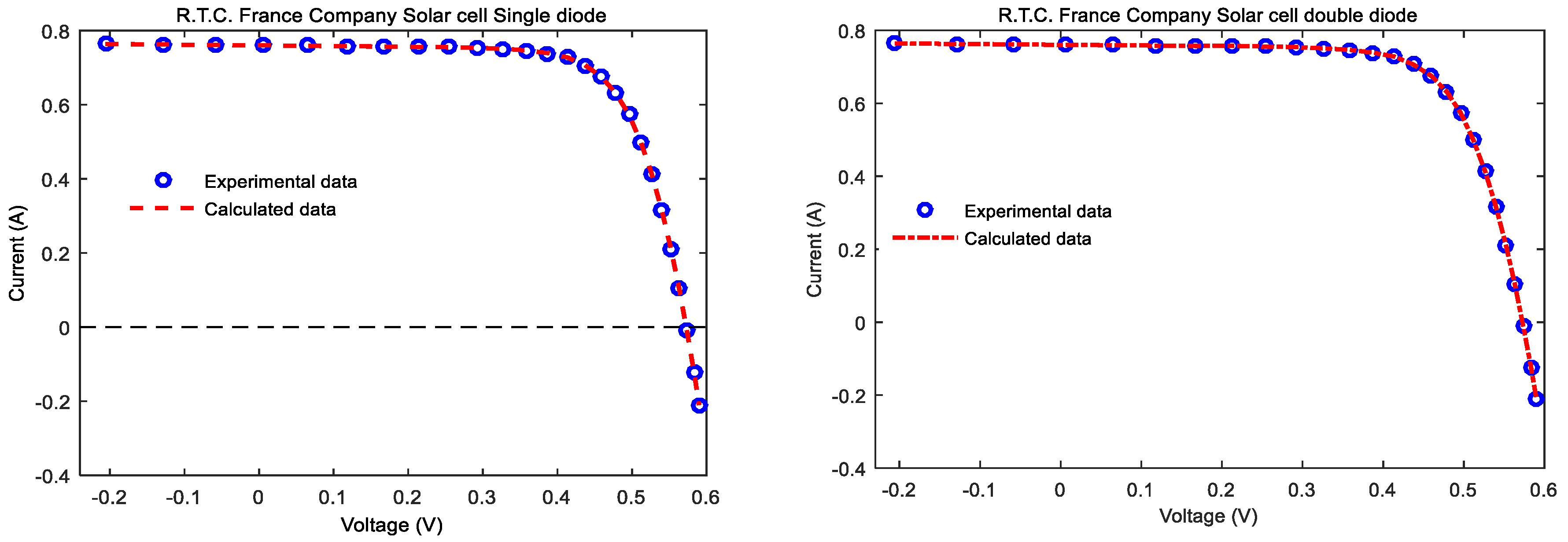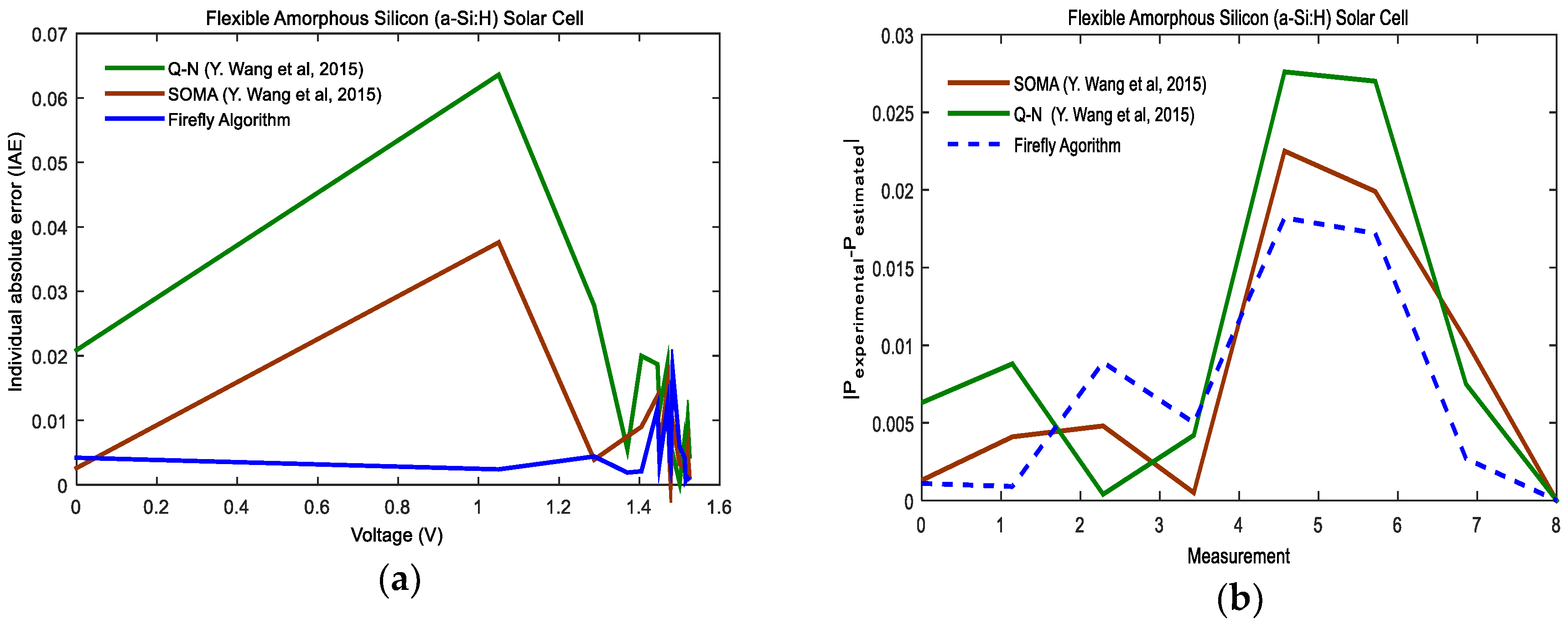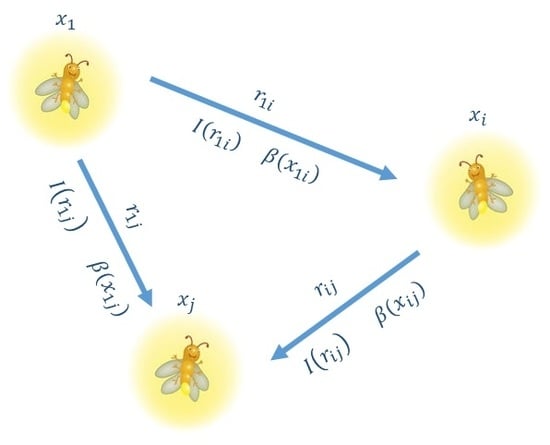1. Introduction
The use of renewable energy sources is rapidly developing, and the application of solar energy focusing on photovoltaic systems is becoming increasingly popular [
1,
2]. The major challenge in photovoltaics system is posed by the instability, nonlinearity and complexity of the current-voltage and power-voltage characteristics equation. The relation between photovoltaic current and voltage is both implicit and nonlinear [
3,
4,
5,
6] and it depends on several factors such as module temperature, solar radiation and its distribution, spectrum, cable losses, dust accumulation, shading and soiling [
7,
8]. Therefore, it is vital to produce a more accurate mathematical model that can better reveal the actual behavior and represent the relationship between current and voltage. In this context, many mathematical models have been developed in the literature to describe the electric, dynamic and thermal behavior of photovoltaic cell/module with a different level of complexity. In particular, the solar cell can be modelled as a static model for DC/DC (direct current), or as a dynamic model for DC/AC (alternating current) with capacitance and parallel dynamic resistance, with diode and photocurrent as proposed in [
9,
10,
11]. They can be classified globally into two categories: implicit and explicit models [
12,
13]. The former [
5,
14,
15,
16] need iterative numerical methods to solve the nonlinear current-voltage equation. On the other hand, the latter models are based on simple analytical expressions [
4,
17,
18,
19,
20,
21,
22]. Different physical models were compared on photovoltaic power output prediction in [
23] and available models of solar cell are presented in [
24]. A different photovoltaic model used for 24-hour-ahead forecasting using neural network is presented in [
25], while a comparison between physical and hybrid methods is given in [
26] and artificial neural network models are employed in [
27]. These models differ mainly by the number of diodes, the presence or absence of a shunt resistor, and by the numerical methods used to determine the unknown parameters. Further, the two diodes model is known as the most accurate model for representing the equivalent electrical circuit. While the single diode model is the most commonly used of the two types; in the simplified four-parameter model neglecting shunt resistance by assuming it as infinite value, and in five-parameter models by maintaining the effect of the shunt resistance. The five and seven parameters models evaluate the photocurrent, the saturation current, the series and shunt resistors and the quality factor of the diode. The eight parameters model adds build-in voltage, thickness, average mobility-lifetime.
The exponential non-linearity of current-voltage equations causes many difficulties in prediction and extraction of the electric, dynamic or thermal parameters [
28] while, the implicit models are not capable of determining the behavior of the photovoltaic cell/module under many effects. Furthermore, solar cell models have multi-modal objective functions and model parameters vary with operational conditions such as temperature and irradiance. The main problem is to identify the optimal parameter values such as photo-generated current, diode saturation current, series resistance, and diode quality factor. Over the years, various papers have been presented and developed different techniques to identify the optimal values of the electric parameters to describe the behavior of the characteristics. These can be categorized into analytical methods, numerical methods and metaheuristic methods. There are several analytical and numerical (generally gradient-based) methods, as described in
Table 1.
Metaheuristic methods are powerful in local searches, but they tend to get trapped in locally optimal values and depend on the photovoltaic module’s manufacturer’s data such as open circuit, short circuit, and maximum power points. Since the photovoltaic cell has triple non-linearity in current-voltage, power-voltage and in intrinsic parameters, deterministic methods cannot extract parameters accurately based on current, voltage and current derivatives with respect to the voltage at short circuit current, maximum power and open circuit voltage. The derivation imposes several model restrictions such as convexity, continuity and differentiability conditions; moreover, the approximations also reduce accuracy. Due to their great potential in modern global optimization resolution for nonlinear and complex systems, the use of metaheuristic bioinspired optimization algorithms to carry out minimizing procedures has received considerable attention. Metaheuristic methods are stochastic methods inspired by various natural phenomenon, as listed in
Table 2. They have been proven to be a promising alternative to deterministic methods applied to the parameter identification of solar/photovoltaic models.
However, the cited algorithms are usually trapped at local optima and they have large error values [
62]. In fact, the performance of these algorithms highly depends on the settings of specific parameters, such as, for instance, the mutation probability, crossover probability, and the selection operator in the genetic algorithm, as well as the inertia weight, and social and cognitive parameters in particle swarm optimization. Therefore, researchers are still searching for powerful algorithms capable of predicting the optimal parameters of different technology under various conditions with less errors.
Metaheuristic bioinspired algorithms have been suggested for parameter extraction and have become an important part of modern optimization. Most metaheuristic algorithms are based on natural or artificial swarm intelligence. Particle swarm optimization is a good example, it mimics the swarming behavior of bees and birds [
62]. Recently, a new metaheuristic search algorithm called the firefly algorithm (FA) has been proposed and developed by X. Yang [
63]. The FA is a nature-inspired stochastic optimization algorithm based on the flashing patterns and behavior of swarming fireflies [
64]. The FA has become an increasingly valuable tool of swarm intelligence that has been applied in almost all areas of optimization, as well as in engineering practice [
65]. It uses a kind of randomization by searching for set solutions, inspired by the flashing lights of fireflies in nature. This algorithm differs from many swarm intelligence techniques [
65] for these two features:
In [
67] the authors provide a detailed background and analysis of the firefly algorithm and test it in a wide range of problems to solve multi-objective dispatch problems.
In this paper, the authors propose a comparison among bioinspired algorithms for the prediction of solar cell and photovoltaic module parameters. The goal is to minimize the multi-objective functions adapted to minimize the absolute errors between experimental and calculated current-voltage data under inequality constraint functions. Three different cases are examined as follows: single and double diode models of a commercial mono-crystalline silicon solar cell (R.T.C France company) at 33 °C, based on current-voltage experimental data recorded in [
29]; (ii) flexible dual junction amorphous hydrogenated silicon a-Si:H solar cell under standard sunlight, based on data obtained in a light intensity of 1000 W/m
2 and at a temperature of 300 K [
54]; (iii) a Photowatt-PWP 201 photovoltaic module which 36 polycrystalline silicon cells are connected in series and the data is measured at an irradiance of 1000 W/m
2, and a temperature of 25 °C [
29]. To verify the performance of the proposed approach and the quality of the obtained results, statistical analyses are carried out to measure the accuracy of the calculated parameters and model suitability. The results obtained are compared with recent techniques such as the Biogeography-Based Optimization algorithm with Mutation strategies (BBO-M) [
68], Levenberg-Marquardt algorithm combined with Simulated Annealing (LMSA) [
47], Artificial Bee Swarm Optimization algorithm [
48], Artificial Bee Colony optimization (ABC) [
49], hybrid Nelder-Mead and Modified Particle Swarm Optimization (NM-MPSO) [
50], Repaired Adaptive Differential Evolution (RADE) [
59], Chaotic Asexual Reproduction Optimization (CARO) [
69] for solar cell single and double diodes. For organic flexible hydrogenated amorphous silicon, a-Si:H solar cell will be compared with the Quasi-Newton (Q-N) method and Self-Organizing Migrating Algorithm (SOMA) [
54]. The optimal parameters of Photowatt-PWP 201 are compared with the Newton-Raphson [
29] Pattern Search (PS) [
55], Genetic algorithm (GA) [
56] and Simulated Annealing algorithm (SA) [
58]. The obtained results are in accordance with experimental data, there is good agreement for most of the extracted parameters and the proposed algorithm outperformed the compared techniques.
2. Presentation and Modelling of the Solar Cell
The electrical behavior of the solar cell is modelled by its outputs current versus voltage characteristic. Further, a solar cell is mathematically modelled in two common methods [
24,
70], single diode (SDM) and double diode (DDM), with consider parasitic phenomena by series and shunt resistances. Moreover, the flexible hydrogenated amorphous silicon a-Si:H solar cell with loss current
is paralleled with the original photo-generated current source and the current sink representing the recombination current in the
i-layer of a P-I-N solar cell [
71,
72,
73,
74,
75]. The two models are given in
Figure 1.
The current-voltage behavior of a solar cell is described according to the electrical intrinsic parameters and nonlinear implicit equation, for a given illumination and temperature.
where,
Iph is the photocurrent,
ISD1 and
ISD2 are the saturation currents,
and
are the diffusion and recombination diode quality factors;
Rs and
Rp are the resistances in series and parallel, respectively,
is the thermal voltage (which will be defined in the followings), and:
The current-voltage characteristic of a flexible solar cell is:
where, the voltage
represents the built-in field voltage over the
i-layer, in single junction amorphous silicon solar cells, and in [
76] it has been determined to be in the range 0.9 V;
di represents the thickness of the
i-layer, the effective
µτ-product
(µτ)eff represents average mobility-lifetime product for election and hole, and quantifies the quality of the active layer in terms of recombination of photo-generated carriers. The thermal voltage is
where
K is Boltzmann’s constant,
T is the cell absolute temperature in Kelvin and
q is the electronic charge,
a is the diode quality factor.
The photocurrent
describes the irradiation dependent recombination in
i-layer and reduced by the recombination current, as follows:
where,
Irec is the current sink and it represents the recombination current in the
i-layer of a P-I-N; the current through the diode represents the diffusion process of charge carriers and the last term represents the shunt leakage current
and is modelled as a space charge limited current [
77,
78].
In Equations (1) and (3), the five, seven and eight parameters which define the current versus voltage relation of solar cell and photovoltaic module, vary in accordance with solar irradiance, cell temperature and depend on reference values reported on datasheet.
3. Problem Formulation
The solar cell can be modelled by using the single diode model, double diode or multi-diode models. The objective function is defined from Equations (1) and (3), several research papers use different functions, for example, [
48,
49,
50,
59,
68,
69] use the root mean square error (RMSE), [
47] use the sum of squared error (SSE). In [
55,
58] the individual absolute error (IAE) is used and [
79] use the mean absolute errors (MAE). However, the objective function was used to minimize the vertical distance between the experimental points and the theoretical curve. In this paper, we use separate fitting for different regions in the current-voltage characteristics (
Figure 2), because the current error is more important for small voltages due to the strongly varying slope of the curve, while the voltage error is more important for large voltages approaching an open circuit.
During the optimization process, each -th solution is defined by a vector , where is a candidate set of parameters defined as follows:
for a single diode: ;
for a double diode: ;
for a flexible solar cell: .
The objective functions must be minimized with respect to the limits of parameters x1, x2 and x3. The Equations (1) and (3) is rewritten in the following homogeneous equations.
For a single and double diode:
For flexible hydrogenated amorphous silicon, a-Si:H:
The cost function of current error
near the short circuit (zone 1) is:
The cost function of voltage error
is the horizontal distance between the experimental point and calculated curve; it is defined near the open circuit (zone 2) as:
Where
m is the number of experimental data,
and
are the
i-th simulated and experimental current and voltage value, respectively. The overall objective function, i.e., the global error
in the two zones, is the sum of current and voltage errors and is defined as:
The objective function constraints for each model are presented in the following equations. For a single and double diode:
While, for flexible hydrogenated amorphous silicon, a-Si:H:
5. Results, Discussions and Comparison
In order to evaluate the efficiency of the Firefly algorithm in the estimation of the solar cell, the photovoltaic module and the array parameter extraction, the results are compared with analytical methods, numerical methods and metaheuristic algorithm to validate the effectiveness of the algorithm. In order, to compare it with other algorithms, a benchmark commercial solar cell and benchmark photovoltaic module are selected in single diode, double diode and photovoltaic module models are considered. The study test cases are designated as follows:
Test scenario 1: Apply to commercial solar cell for both single diode and double model under standard irradiance level with relevant example comparisons to other methods.
Test scenario 2: Apply to a flexible hydrogenated amorphous silicon a-Si:H photovoltaic cell using single diode module.
Test scenario 3: Apply to a commercial photovoltaic array using the single diode model, with 36 solar cells connected in series.
The current-voltage measurements are collected from [
29,
54] and have been widely used by different papers to test electric circuit models, modelling or translate the current versus voltage and technique for parameter extraction. Furthermore, statistical analyses are carried out to measure the accuracy of the estimated parameters and model suitability.
5.1. Case 1: Single and Double Diode Model (RTC France Company)
The proposed algorithm is applied first to extract the electrical intrinsic parameters values for single and double diode models of a 57-mm-diameter commercial (RTC France) silicon solar cell under 1000 W/m
2 at 33 °C. The extracted parameters are compared with those found by: Biogeography-Based Optimization algorithm with Mutation strategies (BBO-M) [
68], Levenberg-Marquardt algorithm combined with Simulated Annealing (LMSA) [
47], Artificial Bee Swarm Optimization algorithm [
48], Artificial Bee Colony optimization (ABC) [
49], hybrid Nelder-Mead and Modified Particle Swarm Optimization (NM-MPSO) [
50], Repaired Adaptive Differential Evolution (RADE) [
59], Chaotic Asexual Reproduction Optimization (CARO) [
69], and the results for each model are reported in
Table 3 and
Table 4.
To confirm the accuracy of the extracted optimal values found by the Firefly algorithm, the calculated currents for the single and double diode model by optimized parameters are summarized in
Table 5 and
Table 6 compared with individual absolute error (IAE).
Furthermore, to understand the quality of the curve fit between Firefly algorithm values and experimental data, the results are compared to other algorithms. The compared statistical analysis for each model is presented in
Table 7 and
Table 8. The compared statistical criteria indicates that the Firefly algorithm ranks the overall lowest values for relative error (RE), median absolute error (MAE), residual sum of squares (SSE), and root mean square error (RMSE). The statistical errors are used to show the performance with the definitions as follows:
From
Table 7 and
Table 8, we observe that the five and seven electrical parameters identified by the Firefly algorithm are close and more accurate than those found by all other compared algorithms. The performance of the proposed algorithm provides the lowest values for the statistical criteria, IAE, RMSE, SSE and MAE when compared to the other methods. Therefore, the Firefly algorithm is ranked first in achieving the lowest IAE, RMSE, SSE and MAE, while the Repaired Adaptive Differential Evolution algorithm and hybrid Nelder-Mead and Modified Particle Swarm Optimization (NM-MPSO) are ranked second and third, respectively. Therefore, the optimal parameters identified by the proposed Firefly Algorithm are very accurate because they are close to the real parameters of the system. The individual absolute error (IAE) and the relative error RE for each measurement using optimal values founded by the Firefly algorithm are illustrated in
Figure 5 and
Figure 6, respectively. The Firefly algorithm performs better than the reported methods.
The current-voltage and power-voltage characteristics resulting from extracted parameters by the Firefly algorithm along with experimental data are compared to estimated data to investigate the quality of the identified parameters. This is illustrated in
Figure 7 and
Figure 8. The two figures show the reconstructed single diode model is in good agreement with experimental data and are very close to each other.
Figure 9 shows the compared extracted current-voltage characteristics of the mono-crystalline for single and double diode, RTC France Company. The calculated current by extracted parameters compared with the Firefly algorithm show good performance with the experimental data for single and double diode.
5.2. Case 2: Organic Flexible Hydrogenated Amorphous Silicon a-Si:H Solar Cell
The Firefly algorithm, based on a parameter estimation method is used to extract the eight optimal parameters of flexible dual junction amorphous silicon solar cell under standard sunlight, based on data obtained in light intensity of 1000 W/m
2 and at a temperature of 300 K. The experimental data are used from [
48]; only the open circuit voltage
Voc and short circuit current
Isc are obtained. Moreover, the optimal parameters are compared with several other techniques based on the same experimental data. The extracted optimal parameters by Firefly algorithm have been reported in
Table 9, compared with the Quasi-Newton method and Self-Organizing Migrating Algorithm. Since it is difficult to extract the flexible amorphous silicon solar cell circuit model parameters and the research is still comparatively rare, the Quasi-Newton (Q-N) method and Self-Organizing Migrating Algorithm (SOMA) [
48] have been chosen for comparison because in [
29,
48] they were demonstrated to provide good results for parameter extractions.
To verify and validate the performance of the quality of the results, statistical analyses were carried out to measure the accuracy of the estimated parameters. The estimated current values are compared to experimental current by means of the following statistical errors: the individual absolute error (IAE), Standard deviation (SD), residual sum of squares (SSE), the root mean square error (RMSE) and the mean bias error (MBE) of the solar cell for each measurement, respectively. The statistical errors are used to compare term by term, the difference between estimated and experimental electric current. Generally, the lower these parameters, the more the efficiency of the model.
Table 10 presents the current calculated for the Firefly algorithm and the individual absolute error,
Table 11 summarizes the statistical errors for each measurement using the optimal values of
x found by the Quasi-Newton method and Self-Organizing Migrating algorithm [
48] compared with Firefly algorithm.
Figure 10 presents the compared individual absolute error of each measurement used for current and power of optimal value
x found by Firefly algorithm compared with the Quasi-Newton method and Self-Organizing Migrating Algorithm. From
Figure 10,
Table 10 and
Table 11 we know that the Firefly algorithm and Self-Organizing Migration Algorithm have the lowest SD, RMSE, SSE and MBE values among these three compared methods. Furthermore, the Firefly algorithm has better performance than the Quasi-Newton method and Self-Organizing Migration presented in [
48].
In order to illustrate the quality of the extracted optimal values
x3 found by the Firefly algorithm, the extracted values of
,
,
,
,
,
,
and
are put into Equation (3), then the current-voltage and power-voltage characteristics of this model is reconstructed with 16 pairs of current-voltage. The current-voltage and power-voltage characteristics resulting from the extracted parameters by Firefly algorithm along with experimental data have been illustrated in
Figure 11. The Figures show the reconstructed model is in good agreement with the experimental data.
The comparative statistical error used in this paper compare the difference between estimated and experimental electric parameters, term by term. The mean bias error (MBE) provides information on the overestimation or underestimation of the solar cell performance. Therefore, the obtained results are more accurate than those found by Q-N and SOMA, can better reveal the actual behavior of solar cells and the model is efficient. Generally, the lower these parameters are, the more the model is efficient.
5.3. Case 3: Commercial Silicon Photovoltaic Module Photowatt-PWP 201
The prototype of the Photowatt-PWP 201 photovoltaic module has six solar panels, two are connected in series and three photovoltaic panels are connected in parallel. The measured voltage and current are taken under 25 °C and 1000 W/m
2. In this case, 26-pair current-voltage measured values are the same as [
29], which are derived from 36 polycrystalline silicon cells which are connected in series. The extracted optimal parameters values for the photovoltaic module by Firefly algorithm have been reported in
Table 12. Moreover, the optimal parameters are compared with several other techniques: Newton-Raphson [
29] Pattern Search (PS) [
55], Genetic Algorithm (GA) [
56] and Simulated Annealing algorithm (SA) [
58] based on the same experimental data. The purpose of comparison is to validate the accuracy of the Firefly algorithm in the parameter extraction process with a short time of convergence.
The quality of the results in the extracted parameters are used to calculate the theoretical current values and compared to experimental measurements as show in
Table 13.
The optimal value of the following statistical errors: individual absolute error (IAE), relative error (RE), root means square error (RMSE) and residual sum of squares (SSE), for each measurement using the Firefly algorithm and other parameter extraction techniques are given in
Table 14.
Table 14 proves that the Firefly algorithm has the lowest IAE, RMSE, SSE and MAE compared to other parameter extraction techniques such as, Newton-Raphson, Pattern Search (PS), Genetic Algorithm (GA) and Simulated Annealing algorithm (SA), since the Firefly algorithm found the minimum value of statistical analysis in parameter extraction for the photovoltaic module.
The comparison between Newton-Raphson, Pattern Search (PS), Genetic Algorithm (GA) and Simulated Annealing algorithm (SA) and the proposed algorithm, with the optimal value of IAE for each measurement, is illustrated in
Figure 12. This Figure shows that the FA algorithm has better performance than the other parameter extraction algorithms. The total IAE values for each measurement is also calculated and listed in
Table 14. The total IAE value shown in
Table 14 highlights that the FA has the lowest total IAE compared to other algorithms for the photovoltaic module.
Table 14 and
Figure 12 indicate that FA outperforms the compared algorithms for this parameter extraction problem.
In order to validate the optimal values
,
,
,
and
extracted by the Firefly algorithm, they are substituted into Equation (1) to reconstruct the current-voltage and power-voltage of the photovoltaic module.
Figure 13 illustrates the current-voltage characteristics of the optimal values extracted by FA along with the experimental data. From the results, it can be observed that the values extracted by FA for the considered photovoltaic module fit the experimental data very well.
From these two cases for the solar cell, the single diode and double diode models, the Firefly algorithm showed the lowest statistical criteria: IAE, RMSE, SSE and MAE values among the compared techniques. We observed that the proposed algorithm is able to extract the intrinsic electrical parameters at the entire range of irradiance and temperature and performance, as compared to other recent techniques.





















